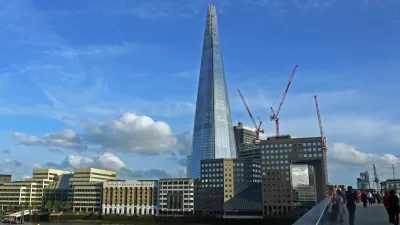Sure, it's a subjective question. Where I live, it's anything taller than four stories, at least in the local media's eyes. But from a real estate perspective, there really is a minimum number, and they are being built in record numbers in the U.S.
Conor Dougherty writes from Minneapolis where he describes one of two new luxury residential high-rises set to open in downtown in August. The Nic on Fifth, a "26-story apartment building that sits smack on a light-rail stop and boasts amenities like a pool deck and a private dog park," is representative of what is becoming increasing more common throughout the U.S. (though I'm not sure how many of these towers can boast private dog parks).
For more information on this transit oriented development, see "The Nic on Fifth Brings Luxury Living to Minneapolis’ Nicollet Mall" by The Opus Group.
Axiometrics, a Dallas apartment-research firm, defines a tower as 15 stories or more, writes Dougherty.
This year, some 74 rental towers are on pace to be completed, and there are 81 on the books for 2015—the highest number since at least the 1970s. At the same time, strong apartment rents and sluggish demand for office space have resulted in some high-rise buildings being converted to apartments. [See chart showing 2005-2015 data].
Dougherty writes that while the high-rise residential towers are more likely to be built in "denser and pricier markets like San Francisco, New York and Chicago, (b)ut in percentage terms, the increase has been most dramatic in smaller cities like Minneapolis, which is building apartments, including high-rise apartment buildings, at the fastest pace in decades."
"It's the Manhattanization of America and it's happening in cities that never had rental high rises," says Mark Humphreys, chief executive of Dallas-based Humphreys & Partners Architects, which specializes in apartments and condominiums.
Going back to the suburban cities that I'm familiar with in the Bay Area, residential opponents, even judges at times (e.g. Redwood City, Calif.) would appear to decry almost any multi-family new development, regardless of its height, as a symbol of the "Manhattanization" of their city. Could that loaded term be taking on a new, more positive meaning?
FULL STORY: High-Rise Apartment Buildings Sprout in Downtowns Nationwide

Alabama: Trump Terminates Settlements for Black Communities Harmed By Raw Sewage
Trump deemed the landmark civil rights agreement “illegal DEI and environmental justice policy.”

Study: Maui’s Plan to Convert Vacation Rentals to Long-Term Housing Could Cause Nearly $1 Billion Economic Loss
The plan would reduce visitor accommodation by 25% resulting in 1,900 jobs lost.

Planetizen Federal Action Tracker
A weekly monitor of how Trump’s orders and actions are impacting planners and planning in America.

Wind Energy on the Rise Despite Federal Policy Reversal
The Trump administration is revoking federal support for renewable energy, but demand for new projects continues unabated.

Passengers Flock to Caltrain After Electrification
The new electric trains are running faster and more reliably, leading to strong ridership growth on the Bay Area rail system.

Texas Churches Rally Behind ‘Yes in God’s Back Yard’ Legislation
Religious leaders want the state to reduce zoning regulations to streamline leasing church-owned land to housing developers.
Urban Design for Planners 1: Software Tools
This six-course series explores essential urban design concepts using open source software and equips planners with the tools they need to participate fully in the urban design process.
Planning for Universal Design
Learn the tools for implementing Universal Design in planning regulations.
Caltrans
Smith Gee Studio
Institute for Housing and Urban Development Studies (IHS)
City of Grandview
Harvard GSD Executive Education
Toledo-Lucas County Plan Commissions
Salt Lake City
NYU Wagner Graduate School of Public Service



























